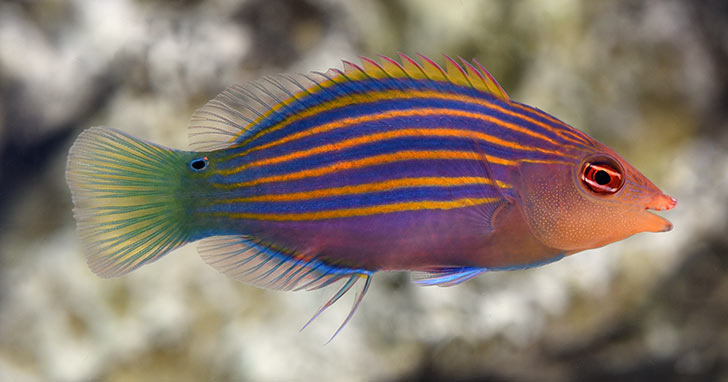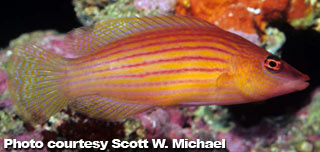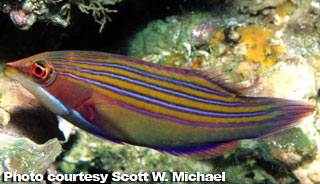The Best Reef Wrasses; Part 5
By Scott W. Michael The genus Pseudocheilinus is comprised of eight small, colorful species. Like other family members, these wrasses are diurnal. All of these diminutive fishes are relatively secretive, remaining under ledges, in large crevices, among rubble or amid the branches of stony corals. Because of their small size, they are a potential target for many predators, hence their wary natures. Unlike some of the other labrids, the Pseudocheilinus spp. do not usually bury at night or when danger threatens - instead, they hide in reef interstices. I have heard a few stories from reputable aquarists that their Pseudocheilinus sp. would bury in fine sand at night. However, I have never seen this. When stressed, these wrasses will form a mucus cocoon when they slumber. Although data on the sexuality and mating systems of the Pseudocheilinus spp. are lacking, there is evidence that it is a protogynous hermaphrodite.
When it comes to their care, the biggest problem with the Pseudocheilinus spp. is that they often suffer from stress related maladies during shipping. In part, this may be due to copious slime production in the bag, which may interfere with respiration. If you get a healthy individual to begin with, these tend to be very durable little fishes. Feed Pseudocheilinus spp. a varied diet that includes finely chopped sea foods, frozen mysid shrimp, frozen preparations for carnivores and a color enhancing flake food. In a reef aquarium, these fishes will only need to be fed once every other day as it will forage on micro-invertebrates on the live rock. Once it acclimates to the aquarium, it is an aggressive feeder that can compete with most fish tankmates. However, make sure newly acquired individuals get enough to eat if housed with boisterous fishes.
The members of the genus Pseudocheilinus are well known for their habit of feeding on pyramidellid snails (small gastropods that are parasites of Tridacna clams). The parasitic snails are nocturnal, spending the day near the base of the clam or between the scutes of certain species of clams. As a result, these wrasses are not likely to encounter the snails very often and have the opportunity to prey upon them. The Pseudocheilinus spp. will also feed on noxious flatworms. That said, do not expect any of them to eradicate these pests if your tank is already infested with them!
Scott Michael Scott W. Michael is an internationally-recognized writer, underwater photographer, and marine biology researcher specializing in reef fishes, and was the Banquet Speaker at our 2007 and 2008 Coral Conference and Frag Swap. He is a regular contributor to Aquarium Fish Magazine, Freshwater and Marine Aquarium Magazine, SeaScope, and is the author of Reef Fishes Vol 1, Vol 2, and Vol 3, Vol 4, and Vol 5., A Pocket Expert Guide Marine Fishes, A Pocket Expert Guide to Reef Aquarium Fishes, 101 Best Saltwater Fishes: How to Choose and Keep Hardy, Brilliant, Fascinating Species That Will Thrive in Your Home Aquarium, Reef Sharks & Rays of the World, and Aquarium Sharks & Rays. Having studied marine biology at the University of Nebraska, Scott has served as a scientific consultant for National Geographic Explorer, the Discovery Channel, and French educational television. |
|||||||||||
|
|



 Food habit data is available for two species. The
Food habit data is available for two species. The
 Pseudocheilinus wrasses can also be aggressive towards closely related, similarly shaped species or fishes added to a tank once they have become established residents. Even the more diminutive Sixline Wrasse can become a big bully if the tank is small and/or docile species are added to its domain. This is less of a problem if your tank is large and replete with hiding places. Larger Pseudocheilinus spp. may thin out your shrimp and crab stocks. They will occasionally leap out of an open aquarium when the lights are extinguished or when they are harassed by other fish. When selecting a specimen, avoid those that are producing excessive amounts of slime, this usually indicates a parasitic skin infection.
Pseudocheilinus wrasses can also be aggressive towards closely related, similarly shaped species or fishes added to a tank once they have become established residents. Even the more diminutive Sixline Wrasse can become a big bully if the tank is small and/or docile species are added to its domain. This is less of a problem if your tank is large and replete with hiding places. Larger Pseudocheilinus spp. may thin out your shrimp and crab stocks. They will occasionally leap out of an open aquarium when the lights are extinguished or when they are harassed by other fish. When selecting a specimen, avoid those that are producing excessive amounts of slime, this usually indicates a parasitic skin infection.


